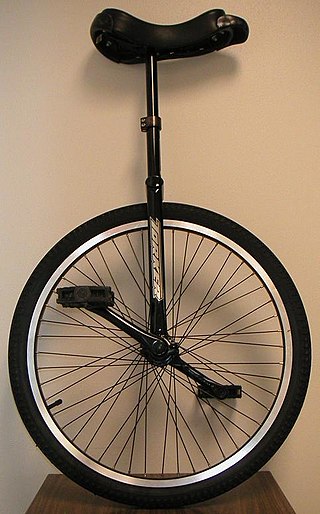
A unicycle is a vehicle that touches the ground with only one wheel. The most common variation has a frame with a saddle, and has a pedal-driven direct-drive. A two speed hub is commercially available for faster unicycling. Unicycling is practiced professionally in circuses, by street performers, in festivals, and as a hobby. Unicycles have also been used to create new sports such as unicycle hockey. In recent years, unicycles have also been used in mountain unicycling, an activity similar to mountain biking or trials.
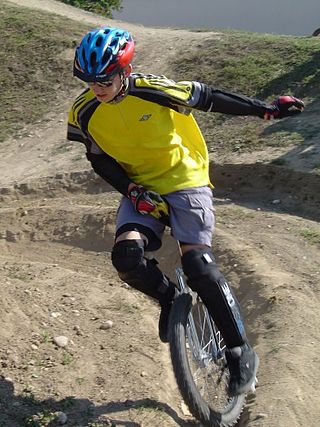
Mountain unicycling is an adventure sport that consists of traversing rough terrain on a unicycle. Mountain unicycling (muni) is undertaken on similar terrain to mountain biking. However, muni requires much more attention to the microfeatures of the short distance in front of the wheel. Unicycles' lack of a freewheel means that descents must be controlled all the way, and the typical lack of a gear system prevents the rider from reaching high speeds. Muni usually takes place on specially designed unicycles, which are equipped with strong hubs, large, knobbly tires, high-grip pedals and rugged frames. Some are also equipped with rim or disc brakes, having the lever mounted under the nose of the saddle. The brake primarily helps to compensate the downhill-slope force, while more expert riders also use it to decelerate or stop.

A tandem bicycle or twin is a form of bicycle designed to be ridden by more than one person. The term tandem refers to the seating arrangement, not the number of riders. Patents related to tandem bicycles date from the mid 1880s. Tandems can reach higher speeds than the same riders on single bicycles, and tandem bicycle racing exists. As with bicycles for single riders, there are many variations that have been developed over the years.

A mountain bike (MTB) or mountain bicycle is a bicycle designed for off-road cycling. Mountain bikes share some similarities with other bicycles, but incorporate features designed to enhance durability and performance in rough terrain, which makes them heavier, more complex and less efficient on smooth surfaces. These typically include a suspension fork, large knobby tires, more durable wheels, more powerful brakes, straight, extra wide handlebars to improve balance and comfort over rough terrain, and wide-ratio gearing optimised for topography and application. Rear suspension is ubiquitous in heavier-duty bikes and now common even in lighter bikes. Dropper posts can be installed to allow the rider to quickly adjust the seat height.

Mountain biking is a sport of riding bicycles off-road, often over rough terrain, usually using specially designed mountain bikes. Mountain bikes share similarities with other bikes but incorporate features designed to enhance durability and performance in rough terrain, such as air or coil-sprung shocks used as suspension, larger and wider wheels and tires, stronger frame materials, and mechanically or hydraulically actuated disc brakes. Mountain biking can generally be broken down into five distinct categories: cross country, trail riding, all mountain, downhill, and freeride.
The impossible wheel, also known as the BC wheel, represents the most basic type of unicycle, consisting of a single, spoked wheel with pegs extending from the axle. The rider mounts the wheel by jumping onto the pegs while in motion or by putting one foot onto one plate or peg and pushing along like a skateboard.
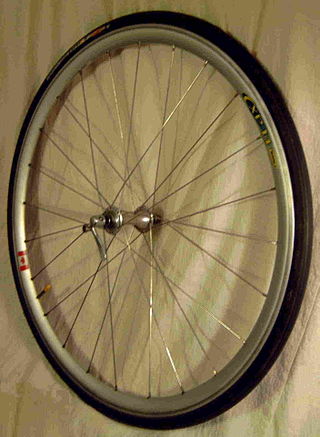
A bicycle wheel is a wheel, most commonly a wire wheel, designed for a bicycle. A pair is often called a wheelset, especially in the context of ready built "off the shelf" performance-oriented wheels.
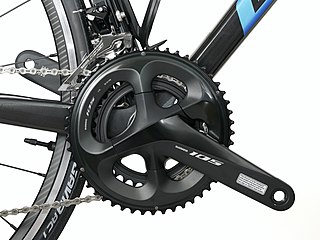
The crankset or chainset, is the component of a bicycle drivetrain that converts the reciprocating motion of the rider's legs into rotational motion used to drive the chain or belt, which in turn drives the rear wheel. It consists of one or more sprockets, also called chainrings or chainwheels attached to the cranks, arms, or crankarms to which the pedals attach. It is connected to the rider by the pedals, to the bicycle frame by the bottom bracket, and to the rear sprocket, cassette or freewheel via the chain.
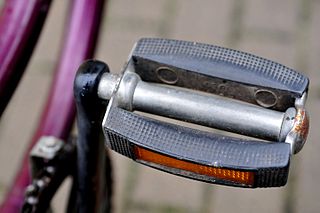
The pedal is the part of a bicycle that the rider pushes with their foot to propel the vehicle. It provides the connection between the cyclist's foot or shoe and the crank allowing the leg to turn the bottom bracket spindle and propel the bicycle's wheels. A pedal usually consists of a spindle that threads into the end of the crank, and a body on which the foot rest is attached, that is free to rotate on bearings with respect to the spindle.

A racing bicycle, also known as a road bike is a bicycle designed for competitive road cycling, a sport governed by and according to the rules of the Union Cycliste Internationale (UCI).

A cyclo-cross bike or cyclo-cross bicycle is a bicycle specifically designed for the rigors of a cyclo-cross race. Cyclo-cross bicycles roughly resemble the racing bicycles used in road racing. The major differences between the two are the frame geometry, and the wider clearances that cyclo-cross bikes have for their larger tires and mud and other debris that they accumulate.
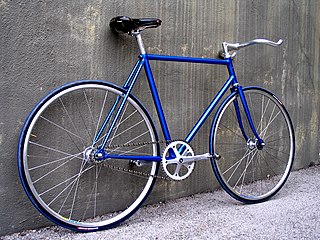
A fixed-gear bicycle is a bicycle that has a drivetrain with no freewheel mechanism such that the pedals always will spin together with the rear wheel. The freewheel was developed early in the history of bicycle design but the fixed-gear bicycle remained the standard track racing design. More recently the "fixie" has become a popular alternative among mainly urban cyclists, offering the advantage of simplicity compared with the standard multi-geared bicycle.

The bunny hop or bunnyhop, is a bicycle trick that allows the rider to launch their bike into the air as if jumping off a ramp. The pedals on the bicycle seem to stick to the rider's feet as the bike becomes airborne, much like how a skateboard seems to stick to the feet of the skater performing an Ollie. While the bunny hop can be quite challenging to learn, once mastered it opens up a whole new level of riding opportunities for both BMX and mountain bike rider alike.

Freestyle BMX is bicycle motocross stunt riding on BMX bikes. It is an extreme sport descended from BMX racing that consists of five disciplines: street, park, vert, trails, and flatland. In June 2017, the International Olympic Committee announced that freestyle park was to be added as an Olympic event to the 2020 Summer Olympics.

Dirt jumping is the practice of riding bikes over jumps made of dirt or soil and becoming airborne. Dirt Jumping evolved alongside BMX racing and is similar to BMX or mountain bike racing in that the rider jumps off of mounds of dirt, usually performing a midair trick in between. It differs in that the jumps are usually much larger and designed to lift the rider higher into the air. Additionally, the goal is not to complete the course with the fastest time, but rather to perform the tricks with the style. Dirt jumping can be performed on BMX bikes or specialized mountain bikes known simply as "dirt jumpers".

A bicycle tire is a tire that fits on the wheel of a bicycle or similar vehicle. These tires may also be used on tricycles, wheelchairs, and handcycles, frequently for racing. Bicycle tires provide an important source of suspension, generate the lateral forces necessary for balancing and turning, and generate the longitudinal forces necessary for propulsion and braking. Although the use of a pneumatic tire greatly reduces rolling resistance compared to the use of a rigid wheel or solid tire, the tires are still typically, the second largest source, after wind resistance, of power consumption on a level road. The modern detachable pneumatic bicycle tire contributed to the popularity and eventual dominance of the safety bicycle.

A motorcycle tyre is the outer part of motorcycle wheel, attached to the rim, providing traction, resisting wear, absorbing surface irregularities, and allowing the motorcycle to turn via countersteering. The two tyres' contact patches are the motorcycle's connection to the ground, and so are fundamental to the motorcycle's suspension behaviour, and critically affect safety, braking, fuel economy, noise, and rider comfort.

Mountain bike trials, also known as observed trials, is a discipline of mountain biking in which the rider attempts to pass through an obstacle course without setting foot to ground. Derived from motorcycle trials, it originated in Catalonia, Spain as trialsín and is said to have been invented by Pere Pi, the father of Ot Pi, a world champion motorcycle trials rider. Pi's father had wanted his son to learn motorcycle trials by practicing on an ordinary bicycle.



















